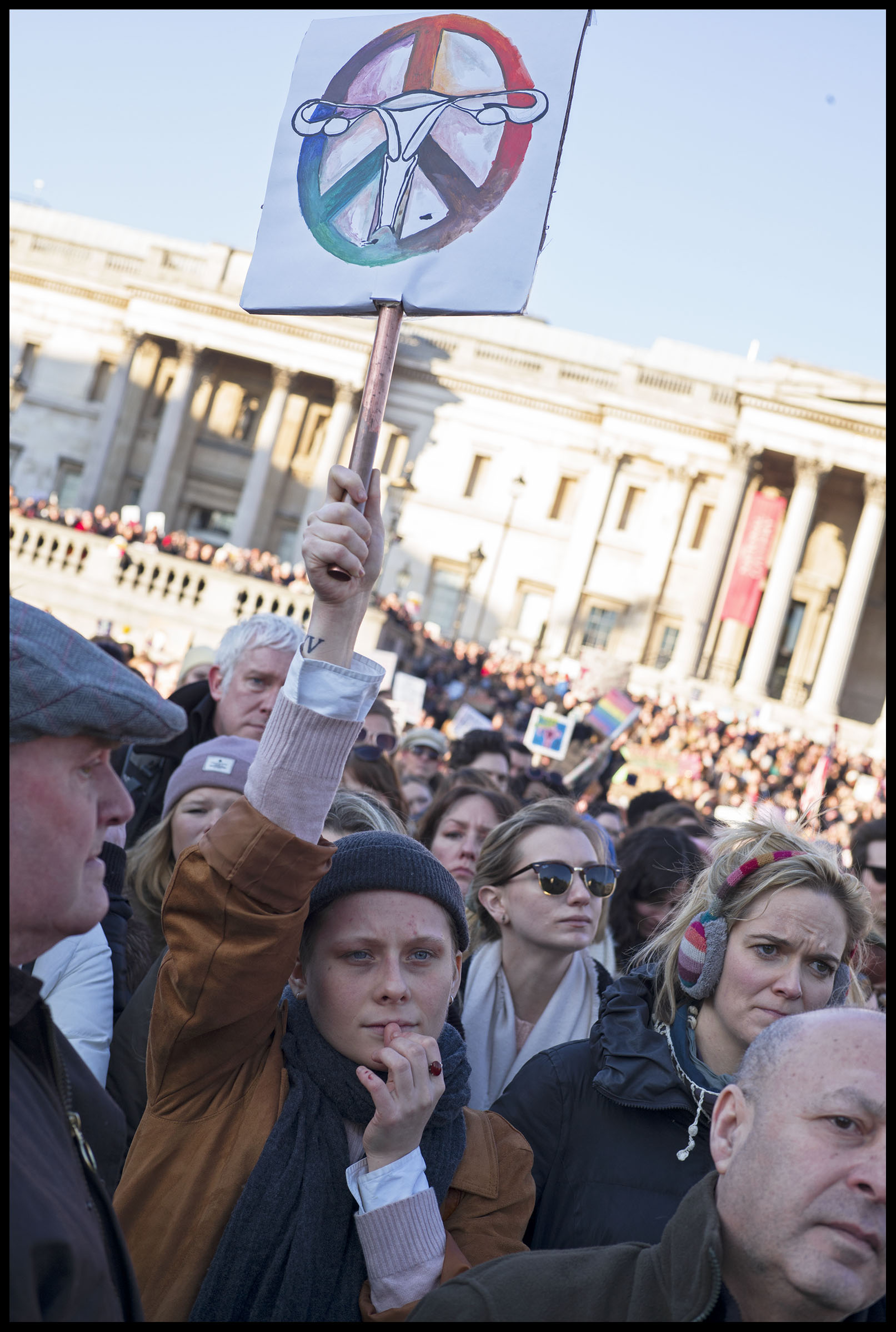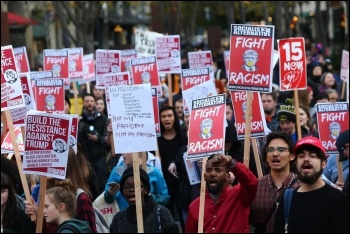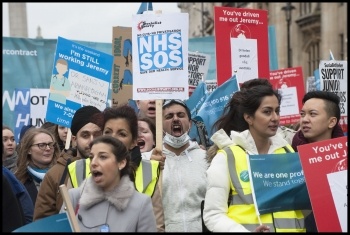Editorial of the Socialist, issue 933
Millions take part in women’s marches around the world
Build a mass movement against Trumpism, austerity and capitalism
The huge turnouts to the ‘women’s marches’around the world on 21 January shocked even the organisers. From Los Angeles to Tel Aviv, from Oslo to Antarctica, millions poured onto the streets to protest Donald Trump’s inauguration as US president. Potentially these demonstrations could mark the beginning of an important new phase in the fightback by young, working and middle class people against the brutalities of capitalism, its political representatives and the divisions they attempt to sow.
The Women’s March on Washington was originally called by feminist groups to express fury at Trump’s outrageous comments on women and the threat his administration poses to their rights. But it, and the hundreds of sister marches it inspired, was taken up by many other groups wanting to give a clear signal from day one of the Trump presidency that his reactionary regime will face mass opposition every step of the way. This snowballed into the biggest coordinated international protests since those against the invasion of Iraq in 2003.
It is now vital and urgent that that this is used as a launchpad to build a sustained, democratic, international movement with a strategy to win and a vision of a socialist alternative. We must ensure that 21 January 2017 goes down in the history books as the turning of the tide, rather than a one-off letting off steam.
Estimates suggest up to five million protested across the world. It is important that so many felt such a strong sense of international solidarity with our sisters and brothers in the US as to protest in their thousands in places that will not all be in the frontline of the direct impact from the Trump presidency. This is partly because of the centrality of the US to world politics generally, and an understanding that instability and reaction there will have a global impact.
But it is also because in reality people were not just protesting against Trump, but against all the many ‘Trumps’ local to them, and against the ‘Trumpist’ policies carried out by capitalist governments around the world. Protesters railed against all forms of sexism, racism and inequality. Some were concerned about Trump’s plans for the environment; others about war and xenophobia. The marches acted as a funnel for much of the discontent people are feeling – brought to a head by fear and anger at what Trump’s election could mean.
Many will have been angered by Theresa May’s comments when asked if she would challenge Trump over his attitude towards women when they meet. She replied that the best thing she could do in that regard was to be there, as a female prime minister. Instead, she said, she would concentrate on ‘pressing global issues’ such as Nato and Syria.
May, regardless of her gender, does not represent the majority of women. It is clear that her priorities in those discussions will be ensuring the security of the capitalist system over the rights and safety of, for example, the millions of women who have been forced to flee Syria. Many of them have been locked out and abused by western governments like hers who are aggravating the situation in the Middle East. And May has supported policies that have led to hundreds of thousands of women in Britain losing their jobs since the Tories came to power. It is expected that by 2020 women will have shouldered 85% of the changes to taxes and benefits since 2010.
A significant section of the marchers recognised facts like these and that they show the need to stay active and escalate the movements in each country, as well as to link different struggles together. Many of those who took part were on their first demonstration – but were clear that it wouldn’t be their last. In Britain, a crucial part of showing solidarity with those in the US fighting Trump’s administration is to fight back against austerity, oppression and capitalism here.
One of the immediate tasks in this is to build for the biggest possible demonstration in defence of the NHS on 4 March. The NHS is clearly a major target for Tory cuts and privatisations – and a potential major mobilising issue for wide layers of workers. For many, the brutal assault on such an essential public service summarises the callousness, cruelty and class-hatred of this government.
In her response to Trump’s inauguration speech, Kshama Sawant, Seattle city councillor and member of Socialist Alternative (cothinkers of the Socialist Party in the US) called for further days of action on International Women’s Day on 8 March and International Workers’ Day on 1 May, concentrating on women’s rights and immigrant rights respectively. We should aim to hold solidarity events for these here, raising the issues affecting these layers in Britain too.
Through all of these individual mobilisations, we must unite the biggest force possible to fight the right. The demonstrations showed a huge openness to this; a desire to turn numbers into real power to defeat Trump, his international counterparts and their ideas. Discussion and debate on the way to build this is vital.
As a starting point, the movement must recognise that it is the capitalist establishment that has allowed the rise of Trumpism. Some people have, by the brutal conditions they face – unemployment, run down public services and sneering from politicians – been pushed towards the false solutions of the right. A movement to defeat it must be intolerant of that capitalist establishment. It must pursue policies that can reach out to those alienated workers and young people.
In the US, this means recognising that the Democratic Party, is inherently tied to the Wall Street establishment. This is why Hillary Clinton could not defeat Trump. The popularity of left-winger Bernie Sanders’ campaign in the Democratic primaries showed the type of radical policies that could have done. It was a mistake that Sanders dropped out and backed Clinton once the Democratic machine had successfully fixed the race against him.
Members of public sector union PCS fighting cuts in the justice sector, photo Paul Mattsson (Click to enlarge: opens in new window)
Following the huge campaign in support of Sanders, and now the burgeoning movement against Trump, the urgent task in the US is to build a new party of the 99%. Such a party, putting forward a bold pro-working class, socialist programme, could seize the opportunities that exist and grow unprecedentedly quickly. The same is necessary all over the world – to fight for a political voice for the working class and developing radical movements. In Britain, this includes striving for victory for Jeremy Corbyn’s anti-austerity stand over the right-wing Blairites in the Labour Party who will stop at nothing to crush it.
The fight for a new party in the US will only become more important as Trump reneges on his promises and lets down those who were wrongly convinced that he represented an anti-establishment vote. Crisis-ridden world capitalism is not going to realise all his pledges of jobs, schools and infrastructure. Clearly, right-wing billionaire Trump will not carry out the socialist policies that could. A new mass workers’ party which vocalised this could win many of those who voted Trump in November. It could also – in contrast to the ‘same-old, same-old’ establishment Democrats – inspire the 42% who abstained in this election to turn out in future.
Another feature of the demonstrations was the number of people explicitly searching for a socialist alternative. Kshama Sawant said in her Trump inauguration response: “In these trying times, I am given great hope by the new found spirit of rebellion among young people. Most important is the growing support for socialism, with thousands joining socialist organisations across the country. The reason why is no mystery: capitalism is a failing system. Donald Trump is a particularly repulsive expression of the predatory nature of the capitalist system itself.
“We found out this week that eight people, just eight people, now own more wealth than half the world’s population. We also found out that global temperatures, for the third year in a row, have broken all previous records – that climate disaster continues to rapidly advance. We need a radically different society. We need socialism. Socialism means a society run by and for working people, rather than the billionaire class. A society where the major corporations are taken into public ownership so we can democratically plan how to use society’s resources to meet human need, rather than private profit.”
A real opportunity now exists to use the momentum evident on the recent demonstrations to build a strong, international socialist movement capable of bringing such ideas to fruition. The Socialist Party and its sister parties in the Committee for a Workers’ International will be at the forefront of these struggles.












